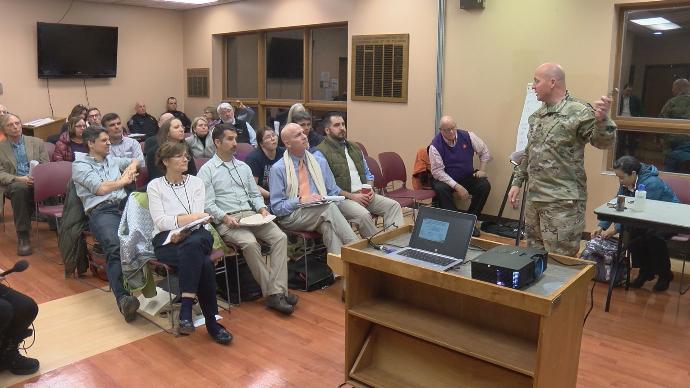Liz Kirchner
communitynews@ourvalley.org

Attendees at Thursday’s RAAP quarterly meeting listen to a presentation given by Lt. Col. James Scott.
In a flurry of outreach, representatives of the Radford Army Ammunition Plant held the year’s final quarterly community meeting at the Christiansburg Library last week, presenting construction updates, public health data and explaining the engineering complexities of munitions disposal.
By the end of the 90-minute meeting, while the community remains wary, Lt. Col. James Scott, who has been plant commander for six months, had extended an unprecedented offer of community visits to the plant.
The plant is the primary supplier of solventless propellants and the only North American manufacturer and supplier of nitrocellulose, an explosive material.
Community meetings have been contentious as citizens voice worries and accusations surrounding the air and water quality and public health impacts of the plant’s operations, especially open-burning disposal of the munitions propellants. Many complaints call for greater transparency from the 7000-acre military base on the New River.
At the meeting, Commander Scott announced the RAAP’s new website with a three-click design and promising responses to questions submitted to the site immediately or within seven days.
Representatives of Army contractor BAE Systems and The New River Valley Health District distributed literature and data handouts.
In response to community concerns around public health impacts, specifically the occurrence of thyroid cancer and heavy metal contamination of the surrounding landscape, New River Valley Health District Director Noelle Bissell, M.D. presented data indicating that thyroid cancer, a complex process, is more likely caused by obesity and smoking than environmental factors, and does not actually occur at high levels in Montgomery County.
“We want to be aware, but we also want to recognize what we know,” she said.
BAE representatives highlighted the plant’s achievements including reducing waste, the disposal of which is the source of community concern.
She said that even during a period when the plant was producing more material, waste production was reduced through technological efficiencies.
“We’ve achieved waste reduction by constructing more modern facilities and improving our processes,“ environmental manager Mary McCoy, P.E. reported.
Following the precisely 30-minute PowerPoint presentation by the plant’s representatives, the floor was open for comments.
The nearly 40 community members, environmental activists, local government and the press that attended expressed concerns about transparency, open burning and asked clarification of results from a drone air quality emissions test performed during the summer.
Several requested that the drone studies be repeated, and asked for outside entities to monitor emissions.
A limited understanding of complex engineering processes led to multiple calls for independent community-chosen experts to design, gather and interpret test results.
“A lot of outside experts are and have been and do look at this. That’s really what our regulatory agencies do as we go through the permitting process. I can assure you this isn’t what the Army decides and then just does. That’s not the way regulatory process [works],” Rob Davies, Deputy to the Commander said.
But community members remained wary.
“They continue to talk about the possibility of a closed air incinerator to replace the toxic open burning that’s going on currently, knowing that citizens are most concerned about that particular issue. However, it doesn’t appear like we are getting much closer. It still seems to be a lot of public relations spin rather than a concrete solution,” Donald Langrehr, a Radford University professor who attended the meeting said.
Blacksburg mayor-elect Leslie Hager-Smith was present briefly. In November, the Blacksburg Town Council passed a resolution calling on the RAAP to increase accountability leveling a number of concerns and accusations the plant called factually incorrect.
Nearing the end of the hour of public comment, in response to a number of calls for access to the plant, Commander Scott made tentative remarks suggesting that would be possible.
“As the arsenal commander, I have no problem we can work together, find a funding source and bring folks on. We can work through the security issues. All that can be worked through,” he said.
We can have intellectual discussions and come up with solutions. I would love to have these meetings on the plant, because I’m vey proud of what the workforce is doing. I think people think it’s just a dirty, chemical wasteland. And it’s not.
The Radford Army Ammunition Plant website is www.jmc.army.mil/Radford/RadfordDefault.aspx.




